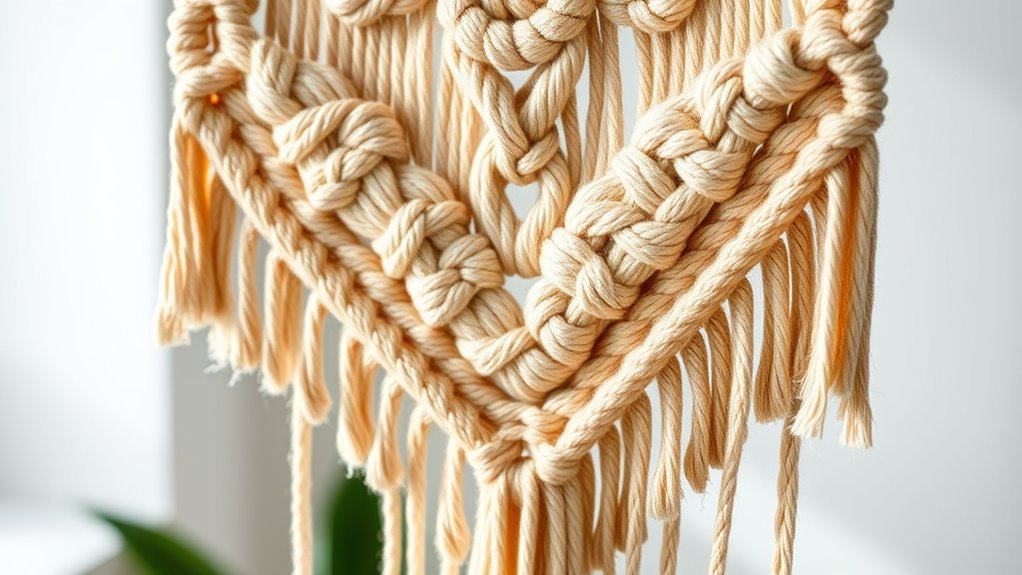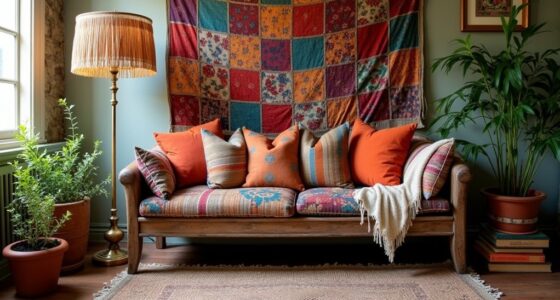In macramé, start with basic knots like the square knot, half hitch, and lark’s head to build sturdy, attractive patterns. Use these knots to create everything from wall hangings to jewelry, choosing fibers like cotton for delicate projects or jute for rustic looks. Mix knot styles and fibers to add texture and complexity. As you practice, you’ll discover endless possibilities for personalized designs, and exploring more techniques will help you craft even stunning textile pieces.
Key Takeaways
- Master basic knots like square knots, half hitches, and lark’s head knots to build a variety of macramé patterns.
- Combine knot techniques such as spiral and double half hitch for textured, complex designs.
- Use different fiber types—cotton, jute, synthetic—to achieve desired aesthetics and durability.
- Apply macramé to home decor, wall hangings, plant hangers, jewelry, and outdoor projects.
- Practice and experiment with knot combinations to personalize and elevate your macramé creations.

Have you ever wondered how to create beautiful, intricate textiles using just knots? Macramé is a versatile craft that transforms simple materials into stunning wall hangings, plant hangers, jewelry, and decorative accents. To get started, it’s essential to understand the different fiber types available, as they influence the look, feel, and durability of your finished piece. Natural fibers like cotton, jute, and hemp are popular choices because they’re easy to work with and add a rustic charm. Cotton, in particular, is soft, flexible, and comes in a variety of colors, making it ideal for intricate patterns and delicate designs. Synthetic fibers, such as nylon or polyester, are stronger and more resistant to weather, perfect for outdoor projects or items that need extra durability. Once you’ve chosen your fiber, you can explore the vast array of knot variations, each lending a unique texture and style to your work.
Mastering knot variations is the key to creating complex patterns and adding visual interest. The basic knots—like the square knot, half hitch, or lark’s head knot—serve as building blocks for more elaborate designs. The square knot, for instance, is a fundamental knot that forms the backbone of many projects, providing both strength and symmetry. The half hitch, on the other hand, allows you to create decorative lines or intricate designs when repeated in different directions. As you gain confidence, you can experiment with more advanced knots, such as the double half hitch or spiral knots, which produce textured, dynamic patterns. Combining these knot variations enables you to craft everything from simple fringes to elaborate geometric motifs.
The elegance of macramé lies in its flexibility—you’re not limited to a single fiber type or knot style. You might use thicker jute for a rugged, bohemian look or fine cotton cords for delicate jewelry. Similarly, mixing knot variations can produce captivating designs, making each piece uniquely yours. Whether you’re creating a minimalist wall hanging or an ornate plant hanger, understanding fiber types and knot variations empowers you to customize your projects. As you practice, you’ll discover endless possibilities for combining textures, colors, and knot styles to produce stunning, handcrafted textiles. Remember, the key is experimentation—try different fibers, learn various knot variations, and let your creativity guide you. With patience and practice, you’ll be able to craft beautiful, intricate macramé pieces that showcase your style and skill.
Frequently Asked Questions
What Tools Are Essential for Beginner Macramé Projects?
For beginner macramé projects, you’ll need a sturdy pair of scissors, measuring tape, and a wooden dowel or ring to anchor your work. These tools help you master cording techniques and understand knot terminology easily. A comb or brush can tidy your cords, while clips or pins keep your project steady. With these essentials, you’ll confidently create beautiful patterns and learn new knots along the way.
How Do I Choose the Right Type of Cord for My Project?
You should choose your cord based on fiber textures and cord thickness. If you want a soft, flexible finish, go for cotton or wool with a smooth texture. For a more structured look, opt for thicker cords like jute or hemp. Consider your project’s purpose—delicate wall hangings need thinner cords, while sturdy plant hangers benefit from thicker, durable fibers. Match fiber textures and cord thickness to your design for best results.
Can Macramé Be Used Outdoors Without Damage?
Imagine you want to hang a macramé plant hanger outside. Yes, it can be used outdoors, but choose cords with weather resistance and UV durability to prevent damage. For example, polyester cords withstand sun and rain better than cotton. Regularly check for fraying or fading, and consider sealing or storing it indoors during harsh weather. Proper material selection guarantees your outdoor macramé stays beautiful and durable over time.
Are There Eco-Friendly or Sustainable Materials for Macramé?
Yes, you can choose eco-friendly materials for your macramé projects. Look for recycled fibers and fibers made from sustainable sourcing, as these options reduce environmental impact. Using recycled fibers helps repurpose waste, while sustainable sourcing ensures you’re supporting responsible harvesting. By selecting these materials, you create beautiful, durable pieces that are kinder to the planet. Plus, you’ll feel good knowing your craft promotes environmental consciousness.
How Do I Troubleshoot Common Knotting Mistakes?
Imagine your knots as tiny bridges, and tension issues as the wind causing them to wobble. To troubleshoot common knotting mistakes, check your tension and tighten loose knots gently. If knots are uneven, undo and redo them with consistent pull. Keep your workspace steady, and don’t rush. This way, your intricate pattern stays steady, and your project becomes a beautiful, balanced piece rather than a tangled mess.
Conclusion
Now that you’ve mastered the art of macramé, you’re basically a fiber whisperer! With your newfound knot-tying superpowers, you could turn a simple string into a masterpiece that stops traffic and makes jaws drop. Whether you’re creating wall art, plant hangers, or jewelry, your skills are now unstoppable. So go ahead—knock everyone’s socks off and turn everyday twine into stunning works of art. The macramé universe is yours for the taking!









